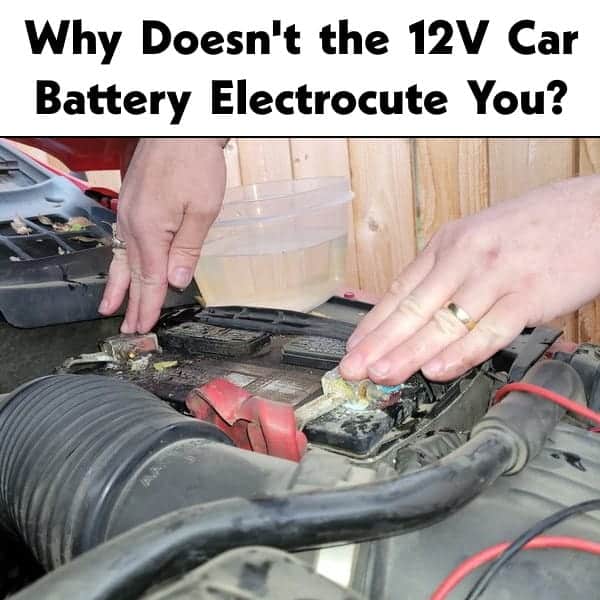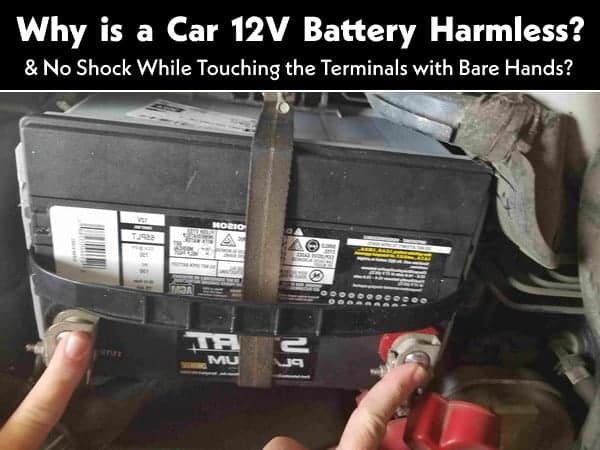Why Can’t a 12V Car Battery Electrocute You?
Why is a Car 12V Battery Harmless and No Shock While Touching the Terminals with Bare Hands?
As we know that current is responsible to kill, not the voltage. But voltage (like a pressure) is needed to flow the current in a conductor. It means, amperes kills, not the volts. Now the question arises here why a 12V battery (household or vehicles) are harmless even with high amperage? Let’s see why doesn’t the car 12V car battery electrocute or hurt you or if there is a chance of electrocution by a 12V car battery.
Keep in mind that the stored voltage in the battery is DC. There is a little bit difference between AC and DC while the effect of electric shock is severe on the human body, no matter which one is more dangerous AC or DC?
To the post, you may have experienced the direct contact of both terminals of the battery with bare hands without feeling an electric shock. Right? Following is the reason behind this magic.
Actually, it is the current which is responsible for saver shock but electric current won’t flow if there is not plenty of pressure (voltage). The next thing is resistance and yes, almost every material has some of them. Similarly, the human body has some resistance (100,000 Ohms in dry condition and 1000 ohms in wet condition).
Related Posts:
Now suppose a human body torches both terminals of battery (positive and negative) with bare hands.
According to Ohm’s law:
Dry Condition where human body resistance = 1 × 105 Ω)
I = V ÷ R
I = 12V ÷ 100,000Ω
I = 0.12 mA
Throughout Wet Condition where human body resistance = 1k Ω)
I = V ÷ R
I = 12V ÷ 1000Ω
I = 12 mA
While analyzing the above calculations, the 0.12 mA (in touching 12V battery in dry condition) is not even sensible while the barely perceptible amount of current is up to 1mA. This is because the voltage is too low to push the current in the body having a high resistance up to 100kΩ. This is the same case of aluminum smelters (where each smelting pot is powered by very high amperage and only a few volts) or welding machine.
Similarly, a low amperes with high voltage even wont kill you. A tabletop Van de Graaff generator generates very high voltage up to 100,000 volts but little amount of electric current and children still playing and enjoying the hair-raising experience without being harmed. This shows, both voltage and current (which is the mixture of electric power) is responsible for severe shock and fatal injuries.
In the second case (touching battery throughout wet conditions, like rain, snow, sweating, humidity) the resistance of the human body reduces up to 1k ohms means there is a chance to flow more current in the human body. In this case, 12mA current is flowing through the human body which is not a good sign. A 3-9 mA current will feel a painful sensation while 9-25 mA current won’t let you go with muscular contraction. And yes, the 12 mA current falls in this category.
There may be a chance of no electric shock even with (a little bit) wet hands (because a high amount of resistance still exists between both hands or the battery has almost discharged or never fully charged). Keep in mind that the above calculations are for a fully wet body (like standing in the rain). So never ever touch the battery terminals with bare hands while rain, snow or wet or sweaty hands.
Related Posts:
- Why Can’t We Store AC in Batteries instead of DC?
- What Happens to the Battery with Reverse Polarity Wiring Connection
- What Happens if a Battery is Connected to the AC Supply?
Conclusion:
A 12V battery won’t electrocute you because the applied voltage from the battery source is not enough to push the required amount of current in the human body having a high amount of resistance. That’s why a 12V DC battery won’t hurt you at all. In other words, it is the electrical energy which leads to serious damage, burn, electrical hazard and even electrocution. In short, the mixture of current and voltage (electric power) is responsible for electrocution.
Precaution:
- Never ever short the battery terminals with conducting materials (it makes a short circuit), otherwise, it will pure at once all the stored power it can which leads to serious injuries and hazardous fire.
- Never ever swap/switch and connect the opposite terminals of battery to the load i.e. negative to positive and positive to negative. If so, there will be a huge surge of power and a higher amount of heat will be produced.
- The leakage (of acid) of the battery can burn your skin.
- A spark or flame very close to the battery may explode due to the hydrogen gas from the battery.
- Shorting the both terminals of the battery may explode the battery and lead to a hazardous fire.
Good to Know:
Photos by: Les Hildenbrandt
Related Posts:
- Is Lightning AC or DC ?
- Difference between AC and DC (Current Voltage)
- Why Do Electronic Circuits Use DC Current instead of AC?
- What Happens When an AC Line Touches a DC Line?
- Why Don’t Birds and Squirrels Get Electrocuted on Power Lines?
- Electrical Shock Hazards & Its Effects on Human Body
- Personal Protective Equipment (PPE) for Electrical Works
- Protective Actions to Avoid & to Reduce Electric Hazardous
- Why A.C needs more insulation than D.C at same Voltage Level?
- Which Bulb Glows Brighter When Connected in Series and Parallel & Why?
- Why Earth Pin is Thicker and Longer in a 3-Pin Plug?
- Why are US Homes Wired Using Solid Wire rather than Stranded Wire?
- Why Does the Heating Element Glow but Not the Cord of Heater?
- Why are Stones laid in an Electrical Substation?
- Why a Transformer Can’t be Operated on DC Supply?
- What happens if You Connect a 3-Φ Induction Motor to 1-Phase Supply?
- What happens to the 3-Phase Motor When 1 Out of 3 Phases is Lost?
- What Happens if We Connect a Polar Capacitor the Wrong Way?








